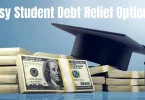If you’re feeling weighed down by student debt, you’re not alone. Millions of Americans struggle with student loans every year, and many wonder how to get student loan forgiveness to ease their financial burden. Student loans can feel overwhelming, especially when juggling monthly payments, living expenses, and other financial goals.
The good news? There are several federal programs, repayment strategies, and employer-based options that can help reduce or even eliminate your student loan debt entirely.
In this guide, we’ll break everything down in a way that’s easy to follow, so you can take actionable steps toward relief.
What Is Student Loan Forgiveness?

Student loan forgiveness is a program where the federal government—or in rare cases, private lenders—cancels all or part of your student loan balance. Unlike refinancing or other repayment options, forgiveness means you may never have to pay back the forgiven portion of your loan.
However, not all borrowers qualify, and eligibility depends on factors like:
- The type of loan you have
- Your repayment plan
- Your employment
- Your years of qualifying payments
Understanding the rules is essential to ensure you maximize your benefits without running into unexpected issues.
Types of Student Loan Forgiveness Programs
There are several ways to pursue forgiveness, each with its own requirements. Let’s take a closer look at the most common programs:
1. Public Service Loan Forgiveness (PSLF)
Who qualifies: Full-time employees of government agencies or qualifying nonprofit organizations.
How it works:
- You must make 120 qualifying monthly payments on a federal Direct Loan.
- These payments need to be made under a qualifying repayment plan, typically Income-Driven Repayment (IDR).
- After 10 years of qualifying payments, the remaining loan balance may be forgiven.
Why it’s powerful:
PSLF can save you thousands of dollars over time, especially if your income is modest but you’re committed to public service work.
Pro Tip: Keep detailed records of your employment and payments. Submitting the PSLF Employment Certification Form annually ensures your payments count.
2. Teacher Loan Forgiveness

Who qualifies: Teachers who work in low-income schools or educational service agencies.
Requirements:
- Teach full-time for five consecutive years.
- Work at a school designated as low-income by the Department of Education.
Benefits:
- Eligible teachers may receive up to $17,500 in forgiveness on certain federal loans like Direct Subsidized/Unsubsidized Loans or Federal Stafford Loans.
Pro Tip: Even if you’re pursuing PSLF later, Teacher Loan Forgiveness can be stacked with certain programs for additional savings.
3. Income-Driven Repayment (IDR) Forgiveness
Who qualifies: Borrowers struggling to make standard monthly payments.
How it works:
- Plans like Income-Based Repayment (IBR), Pay As You Earn (PAYE), and Revised Pay As You Earn (REPAYE) calculate monthly payments based on your income and family size.
- After 20–25 years of consistent payments, the remaining loan balance may be forgiven.
Why it matters:
Even if you don’t qualify for PSLF or Teacher Loan Forgiveness, IDR forgiveness can help make your debt manageable and prevent financial stress from accumulating.
You may also like to read this:
How To Pay Off Loans Faster: Easy Steps To Become Debt-Free
Manage Multiple Student Loans Easily: Complete Guide
Student Loan Payment Tracking Methods Made Easy
Easy Student Debt Relief Options: Reduce Your Loans Fast
Best Debt Relief Programs For Students – 2025 Guide
4. Perkins Loan Cancellation
Who qualifies: Borrowers with federal Perkins Loans, typically issued to students with exceptional financial need.
Eligible professions include:
- Teachers in high-need subjects
- Nurses and healthcare professionals
- Law enforcement officers
- Military service members
How it works:
- Partial or full loan cancellation is available depending on your years of service in qualifying fields.
5. State-Based and Employer Programs
Many states and employers offer loan repayment assistance programs (LRAPs) to incentivize work in high-demand sectors, including:
- Healthcare
- Teaching
- Social work
- Public service
How to find them:
- Check your state’s Department of Education or workforce development website.
- Ask your employer’s HR department about student loan repayment benefits.
These programs often provide direct loan payments or matching contributions, which can speed up your path to forgiveness.
Steps to Qualify for Student Loan Forgiveness
To maximize your chances, follow these steps:
- Check Your Loan Type
Only federal loans generally qualify for forgiveness programs. Private loans rarely do, though some lenders have unique repayment relief options. - Choose the Right Repayment Plan
Programs like PSLF require specific repayment plans, usually Income-Driven Repayment. Confirm with your loan servicer which plan makes your payments count. - Track Your Payments and Employment
Maintain meticulous records of payments, employment certifications, and correspondence with your loan servicer. This documentation is critical if your forgiveness application is audited. - Submit Applications Timely
Each forgiveness program has its own application process. Submit as soon as you meet eligibility criteria to avoid delays. - Stay Updated
Loan forgiveness rules can change based on legislation and policy updates. Subscribe to updates from the Federal Student Aid website to stay informed.
Tips to Maximize Your Chances
- Consolidate Non-Direct Loans: Federal FFEL or Perkins Loans may be consolidated into Direct Loans to qualify for PSLF or IDR forgiveness.
- Verify Everything: Always confirm with your loan servicer that your employment, payments, and repayment plan qualify.
- Keep Detailed Records: Save every pay stub, loan statement, and employment certification form. These documents can be lifesavers if there’s ever a dispute.
- Avoid Scams: Beware of private companies promising “quick forgiveness” for a fee—most of these are scams.
Final Thoughts
Getting student loan forgiveness can feel daunting, but it’s achievable with careful planning, persistence, and the right strategy. Whether you work in public service, education, healthcare, or qualify under an income-driven repayment plan, understanding how to get student loan forgiveness is the first step toward financial freedom.
Start by evaluating your loans, selecting the right repayment plan, and keeping meticulous records. Stay informed about programs and deadlines—you could see your student debt forgiven sooner than you think. With the right approach, your path to debt relief is within reach.
FAQs
1. What is student loan forgiveness?
Answer: Student loan forgiveness is when the government or a qualifying lender cancels all or part of your federal student loan debt, meaning you are no longer required to repay that portion of the loan. It is different from refinancing or repayment plans, which still require you to pay your loans over time.
2. Who qualifies for student loan forgiveness?
Answer: Qualification depends on your loan type, repayment plan, employment, and service history. Most forgiveness programs are for federal loans. Common qualifiers include:
Public service employees
Teachers in low-income schools
Borrowers on income-driven repayment plans
Professionals in certain high-need fields like healthcare or law enforcement
3. Can private student loans be forgiven?
Answer: Generally, private loans do not qualify for federal forgiveness programs. Some private lenders may offer temporary relief or employer-based assistance, but full forgiveness is rare. Consider consolidating private loans into federal loans if eligible, though this has limitations.
4. How long does it take to get student loan forgiveness?
Answer: The timeline depends on the program:
PSLF: 10 years (120 qualifying payments)
Teacher Loan Forgiveness: 5 years of teaching
Income-Driven Repayment (IDR) Forgiveness: 20–25 years of consistent payments
Perkins Loan Cancellation: Varies by profession and years of service
5. Are forgiven student loans taxable?
Answer: Most federal student loan forgiveness programs, including PSLF and IDR forgiveness, are not considered taxable income. However, some state-level programs or other exceptions may have tax implications. Always check with a tax professional.





